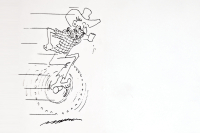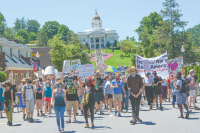Council votes to remove police cameras from tribe’s public records law
 Attorney General Mike McConnell (left) addresses Tribal Council as Police Chief Carla Neadea and Cherokee One Feather Editor Robert Jumper look on.
Attorney General Mike McConnell (left) addresses Tribal Council as Police Chief Carla Neadea and Cherokee One Feather Editor Robert Jumper look on.
D During its April 6 meeting, the Eastern Band of Cherokee Indians Tribal Council unanimously approved an ordinance change exempting police car and body cam videos from the tribe’s public records law. The vote comes on the heels of a Dec. 13, 2022, Cherokee Indian Police Department SWAT response in which officers fired at Murphy resident Jason Harley Kloepfer after he opened the door to his home with his hands held above his head, according to a home security video Kloepfer posted Jan. 18.
The ordinance, submitted by Cherokee Indian Police Department Chief Carla Neadeau , prevents videos from body cams, in-car cameras and law enforcement surveillance systems from being released under the tribe’s public records law, stating that subjecting them to the public records law “is not feasible nor in the public interest.”
After being read and tabled during the March session, the ordinance received a motion to pass and a second moments after coming to the floor April 6. Before the body could vote, Cherokee One Feather Editor Robert Jumper raised his hand to offer comment. Jumper said he understood the need to protect police but worried the ordinance as written would block the public from information that it should have a right to know.
“I understand the need for the protection of the PD and our police and I admire their work,” he said. “The only question I had was in the state they have a provision that you can go to the court and request the video, so I would ask that you consider having that included in the ordinance that there’d be some remedy in case the public does need to see a video.”
While body cam footage is exempt from disclosure under the North Carolina public records law, the statute lays out a process by which a person can seek a court order allowing its release. The law has been criticized as throwing up unnecessary roadblocks to transparency, but it does provide a pathway for footage to become public — even footage the sheriff in question might prefer to remain hidden.
Tribal code does not appear to have a similar process. Under questioning from Tribal Council, Neadeau said that video would have to be subpoenaed to be released. Ostensibly, this would occur as part of a civil or criminal trial pursuing certain charges or seeking relief on certain claims — not as the result of an individual seeking release of a certain video as a matter of public interest. Video of the Dec. 13 shooting had been subpoenaed — but two weeks later, criminal charges against Kloepfer were dismissed and the subpoenas were never executed.
Related Items
However, in his comments to Council, Attorney General Mike McConnell said that video could be released at the discretion of the chief of police and that the courts could be a recourse for public release.
“This just provides a default position that these things are not automatically released by demand,” he said. “Chief of Police could decide yes, this serves a good public purpose. Or if safety is a paramount concern, she can say no, it’s not appropriate at this time. Somebody still could go to the court and say, ‘Please let us see this. There’s a compelling interest for doing so.’ I think the mechanism is available. From the AG’s perspective, I think this is the proper route to go.”
McConnell did not respond to an emailed question asking under what circumstances a court could grant release of a video, but did, in response to a separate question, say that a court could impose restrictions on how footage produced as part of a civil or criminal case is shared.
Members of the CIPD SWAT team shot Kloepfer while responding to his home at the request of Cherokee County Sheriff Dustin Smith, who said he believed his office to be dealing with a potential hostage situation. But the camera robot the SWAT team sent into Kloepfer’s trailer at 5 a.m. showed he and his wife, who he was suspected of harming, asleep and unhurt in bed. Responding to police commands, Kloepfer came to the door with his hands held above his head — at which point officers fired, hitting him twice.
In his original public statement on the incident, Smith painted Kloepfer as the aggressor, writing that officers fired after Kloepfer “engaged in a verbal altercation” and confronted them as he emerged from his camper trailer. Smith later said he didn’t know there were any issues with that version of events until Kloepfer posted the video a month later. He blamed the CIPD for the information in the apparently false initial story.
In a March 27 letter, District Attorney Ashley Welch asked to recuse herself from the case, implying that she had initially charged Kloepfer based on inaccurate information from Smith’s office and stating that she was now a witness in the N.C. State Bureau of Investigation case as a result of statements to her by Smith’s office.
Had Kloepfer not recorded the entire episode on his home security system, the public might have never been the wiser. The video clearly showed him holding his hands above his head at the moment he was shot.
Nobody mentioned the shooting during the April 6 discussion in Tribal Council, however, and nobody except for Jumper expressed concern about placing such a strong barrier to public access of law enforcement recordings. The few representatives who offered comment indicated they saw protection for officers as the priority and cited a desire to give Neadeau “what she wants” in this matter.
“On this here, I think the chief of police are looking out for their law enforcement officers, and that’s what we hire them to do,” said Chairman Richard French. “This comes from the chief of police, and this is how she wants it. Everybody on the Council, anybody’s got any objection, speak up now or I’ve got a move on the floor to pass it as it is.”
Rep. Boyd Owle said he’s received some comments from constituents who want access “to certain things the police department does and that nature” but said he would ultimately defer to Neadeau’s wishes.
“I guess that’s what she wants. She’s at the helm of her department there,” he said, turning to Neadeau. “So you are you fine with this?”
“Yes,” Neadeau replied. “It doesn’t mean that it can’t be subpoenaed. So as long as it’s subpoenaed then we’re fine with that, because the camera footage off the body cams shouldn’t be public record. And it could be a privacy violation. But it doesn’t mean it can’t be subpoenaed.”
Tribal Council concluded its debate within five minutes and passed the ordinance unanimously, with Snowbird/Cherokee County Rep. Adam Wachacha and Big Cove Rep. Teresa McCoy absent. It now goes to Principal Chief Richard Sneed, who has 30 days to either sign it, veto it or let it pass into law unsigned.









